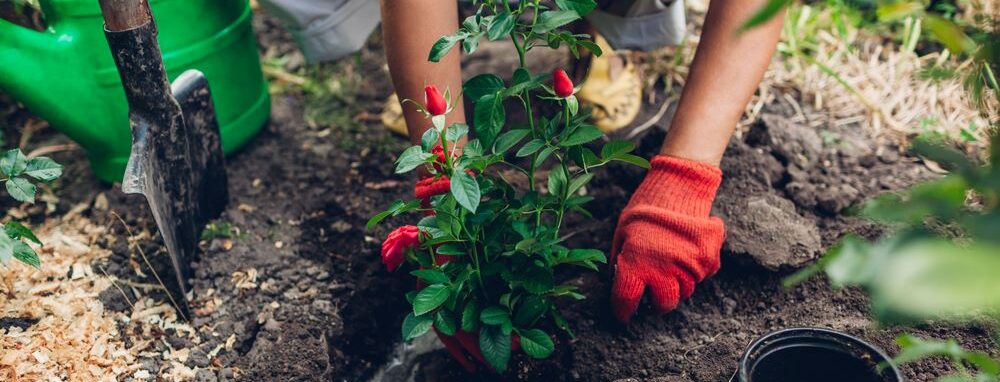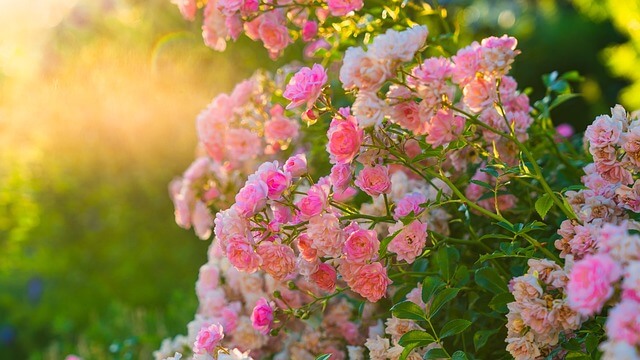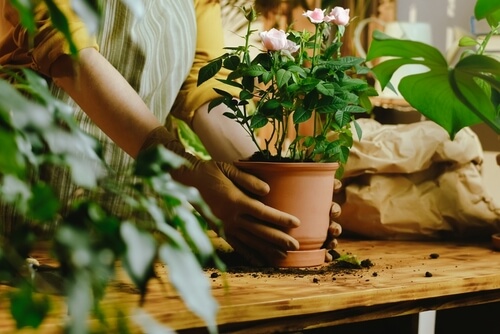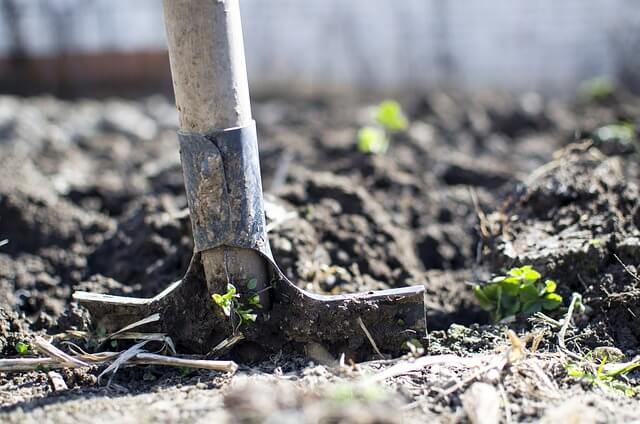Log in or create new account to save this product to your wishlist.

Planting Roses: A complete step-by-step plan
The delicate rose comes from a surprisingly hardy plant. But you'll only receive years of joy from your bush if you give it the best start. Find out how to plant a rose bush here!
🌱 All important maintenance moments for your lawn during the year. Leave your email and we will send you the lawn calendar for free.
Enter your email
Receive the lawn calendar in the mail
Enjoy a green lawn all year round!

- Order by 2PM = shipped today
- 250.000+ satisfied customers!
- 60 day satisfaction guarantee
A garden in England isn’t an English garden without a rose bush. And while there may be few things in life as delicate as a rose, these perennial plants are surprisingly hardy. But planting roses requires a few steps that ensure a long life of stunning blooms and a garden scented with that inimitable scent.
- The best position for your roses
- Planting roses: when?
- How far apart should I plant my roses?
- How deep should I plant my rose bushes?
- How to plant roses: a complete step-by-step guide
- Combining roses with other plants
- Planting roses: the tools
- Planting roses: aftercare
- FAQs
Indeed, roses bring a timeless quality to your outdoor space, whether you plant them pride of place in the centre of your flower border or sturdy pots on your windowsill.
This article goes through a step-by-step guide to planting roses, ensuring your roses provide enduring delight to you, your garden, and our most valuable pollinating insects.
Ready? Let’s go!
The best position for your roses

Understand your plant, and it will provide you with years of attractive flowers and foliage. But if you plant it in the wrong position, it will fail to thrive.
Roses thrive best in a sunny spot. And while some varieties are tolerant of partial space, most roses are sun worshippers.
In other words, avoid planting roses in the shade.
Choose a sunny, uncrowded spot. Remember, rose bushes can grow large, so you need to give your bush plenty of space. Roses need air and plenty of room between the branches so they can dry out after a shower — this helps prevent fungal infections.
What type of soil do roses need?
Roses don’t grow well in wet peaty soil or dry sandy soil. They prefer loose lime soil but can also thrive in rich, moist sandy soil if you fertilise the flowerbed regularly.
If you have heavy clay soil that’s prone to flooding, mix it with potting soil or well-rotted mulch or compost to improve drainage.
Not sure what type of soil you have in your garden? Check out our expert’s guide to garden soil (and how to improve it).
Planting roses: when?

The answer to “When should I plant my rose bush” depends on your local climate and the type of rose you plan to plant.
In general, the best time to plant roses in the ground is in autumn — October is prime time! This is because the soil is still warm from the summer, and the water table is high.
However, it’s also possible to plant your bushes in February and March, all the way to the end of April — just wait until the soil has begun to warm up after winter and the frost risk has passed. This gives the plant time to settle in its new spot before the warmer summer months arrive.
But:
You can plant roses in pots any time of year if you use good potting soil. However, avoid planting your bush during or before frost.
Planting roses in March
Many people prefer planting their roses in March. This gives the plant a good headstart, benefitting from the entire growing season.
But:
Make sure the soil is free from frost and that no further frost is expected. March can still be cold, so watch the weather before planting.
Planting roses in autumn
Most plants prefer being planted in spring, but roses are generally very happy to be planted in the autumn, while the soil is warm and they have time to settle in before winter.
Water your roses well once planted, and mulch around the plant’s base to help protect the roots from the cold as winter approaches.
How far apart should I plant my roses?
It’s essential to give your rose bushes enough room to grow. Remember, a new plant will probably quadruple in size, so you should leave between 60-90cm between each plant.
This gives the plant ample space to grow and spread. Don’t be tempted to plant your roses too close together — it hinders air circulation and could cause fungal diseases.
How deep should I plant my rose bushes?

Dig a hole big enough to bury the highest root branch at least 10cm below the soil surface. So, for safety, go for a hole around 60cm deep and 60cm wide.
Always plant the grafting site (the point at which the rose is grafted onto the rootstock) just below ground level. This ensures the plant roots firmly and protects the grafting site from frost.
Make sure your planting hole gives your plant the space to spread its roots, especially if you have heavy soil.
How to plant roses: a complete step-by-step guide
Follow these instructions for excellent results every time:
- Choose a good location for your roses. Remember, unless you have a shade-tolerant variety, select an area that enjoys full sun throughout the day.
- Soak the roots of your new plants in lukewarm water overnight. This ensures the plant is well-hydrated and will cope with the shock of repositioning.
- Prepare the planting site by:
- Mixing in a bucket of well-rotted organic matter, such as compost or farmyard manure per square metre. Digging it into the top 30cm of soil.
- For optimal results, also apply 3g of general fertiliser per square metre.
- For each plant, dig a hole at least twice the width of the plant’s existing rootstock and 50cm deep.
- Loosen the soil around the rootstock and separate individual root strands — this helps them spread once planted.
- Spread the roots and fill the planting hole with good-quality soil.
- Water immediately and gently press the surrounding soil to help stabilise the top-heavy plant.
Combining roses with other plants

One of the best ways to make your garden even more beautiful is to combine roses with other plants. You can create a stunning display by combining and contrasting different colours, shapes, and textures.
Plants that combine well with roses are:
- Lavender
- Sage
- Sun-loving annuals, like heliotropes, lantana, verbena, and petunia
- Scented geraniums
- Parsley and thyme (could help avoid beetles and aphids)
- Marigolds (could help repel pests)
Planting roses: the tools
Of course, the most obvious tool is a spade because you’ll need to dig the hole. Other than that, there’s not much else you’ll need other than a watering can/hose and gardening gloves — always remember to use gardening gloves when handling thorny roses.
Some rose varieties (such as the stem rose) will need support, such as staking or trellising. Always read the plant label before planting and follow those instructions to get the most out of your rose bush.
Planting roses: aftercare
Water your new rose bushes regularly, especially during dry spells. Don’t let the soil dry out.
And all roses love a good feed, particularly horse manure.
The optimal time for manure is during planting, but you can also use manure as winter mulch around the base of the plant to help keep the soil warm while nutrients slowly soak into the ground throughout the winter.
Weed around the base of the plant and remove dead leaves and branches to prevent fungal infections.
Prune your roses in early spring to promote growth and maintain the plant’s shape. Check our expert’s guide to pruning roses for the full lowdown.
Fertilise your rose bushes in the spring, then again after the first flowering to promote the formation of new buds. And feed again in winter with a mix of compost of horse manure or manure granules.
FAQs
Avoid planting during or before frost. The optimal time to plant roses is autumn, but you can also plant as early as February or March if the soil is warming up after winter. Choose a spot in full sun and leave 60-90cm between each rose bush. Prepare the ground with good manure and compost before transplanting.
Roses thrive in loose lime soil but also do well in any nutrient-rich or moist sandy soil. Mix heavy soil with soil improver and manure before planting to improve drainage.
The general rule is to plant the highest root branch 10cm below the soil surface. Also, plant the frost-sensitive grafting site 5cm below the soil surface.
Any questions?
I hope I’ve provided all your questions about planting roses, but if you have any questions, don’t hesitate to get in touch.
Or you could check MOOWY’s Help & Advice section — I like to call it our online gardening encyclopaedia.
Thanks for reading! And happy growing!
-
Orchids: A Complete Guide on How to Care for ThemWant to give your orchid the best possible care? Discover essential tips from placement to watering and pruning. Learn everything you need to know!Read more
-
Growing Wisteria Made Simple: From Planting to Perfect BloomsWith blossoms like a purple waterfall, Wisteria sets an almost magical and colourful mood. If you want to grow this beauty in your garden, you’ll need a bit of patience. Don’t worry, it will most definitely pay off.Read more
-
How to Build a DIY Greenhouse: A Practical Guide for Smart SpendersImagine extending your growing season throughout the year, nurturing tender plants regardless of the weather, and creating a personal garden sanctuary. This is precisely what a DIY greenhouse offers you. Let’s learn how to build one.Read more
-
How to Grow Eucalyptus in British GardensWith a little love and care, eucalyptus trees can thrive in English gardens. Since they don’t germinate well without proper help, there are not considered invasive. So, there is no reason not to plant them if you enjoy their looks.Read more
-
Transform Your Garden with All-Year-Round Flowering PlantsDid you know you can enjoy blooming flowers even in January? With the right selection of all year round plants, there’s no need to wait until spring to add some colour to your garden.Read more
-
How to Create a Butterfly Garden: A Simple Guide for British GardensThe UK's butterfly population includes 59 different species. These beautiful winged creatures face a steady decline because of habitat loss, pollution and changing weather patterns. Your garden can become a vital link between nature reserves and natural habitats. Let’s explore how.Read more
-
Volcanic Rock Dust for Your Garden—Application and TipsDid you know that volcanic rock dust is a brilliant organic soil improver? This article explains exactly what it's good for and how to use it properly.Read more
-
How to Use Landscape Fabric ProperlyIf weeds or erosion in your garden are troubling you, landscape fabric might be the solution. We’ll explain how and when to use it properly, just keep on reading.Read more
Leave a comment
Your answer will be displayed on the site and the interested party will be notified by email.
Leave a comment
Have a question or want to share your experience? Leave us a comment.

- Order by 2PM = shipped today
- 250.000+ satisfied customers!
- 60 day satisfaction guarantee

- Order by 2PM = shipped today
- 250.000+ satisfied customers!
- 60 day satisfaction guarantee

🌱 All important maintenance moments for your lawn during the year. Leave your email and we will send you the lawn calendar for free.
Enter your email
Receive the lawn calendar in the mail
Enjoy a green lawn all year round!






















Comments (0)
There are no comments yet. Well then, what are you waiting for to
Be the first to write your comment!inaugurate this pretty page?
Do you have some comments?